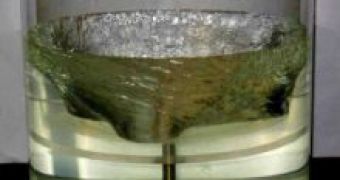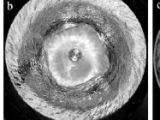Strange things happen when you rapidly rotate the bottom plate of a cylindrical container filled with water. Physicists in Denmark conducted this experiment as part of their lab study of tornadoes. But what they found was totally unexpected: polygons with up to six corners forming in the middle of the rotating water.
When water is rotated, it moves toward the wall due to the centrifugal force. When the speed is high enough vortexes and other instabilities appear. The present experiment, performed by Tomas Bohr and colleagues at the Technical University of Denmark in Kongens Lyngby and the Niels Bohr Institute in Copenhagen, is different from all previous experiments because the sides of the container have been kept still while only the bottom rotates.
The bucket is made of Plexiglas, is about 20 cm across and contains a rotating plate underneath. Bohr and co-workers filled the container with water and set the plate rotating. When the rotation rate became sufficiently large, deformations in the form of polygons with up to six corners had appeared on the surface of the fluid.
Researchers then used ethylene glycol, which is about 15 times more viscous than water. They observed three-cornered polygons and in some cases vortices formed near the polygons' corners.
Scientists don't yet understand why the polygons form but they plan to repeat the experiment with containers of different diameters and with fluids that are more viscous. "The variation with these parameters should give us significant information about the origin of the structures," said Bohr.
A video and more pictures can be seen here.
Photo credit: Bohr et. al. Phys. Rev. Lett. 96 174502

 14 DAY TRIAL //
14 DAY TRIAL // 
